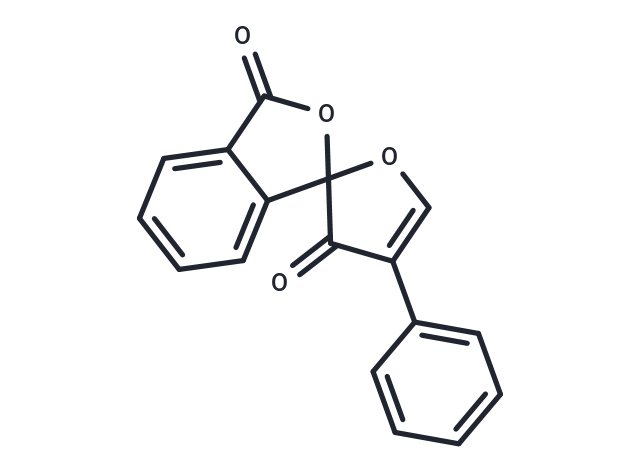Shopping Cart
Remove All Your shopping cart is currently empty
Your shopping cart is currently empty
Fluorescamine (Ro 20-7234) ( Ro 20-7234) is not fluorescent itself but reacts with primary amines to form highly fluorescent products. It is used to detect amines and peptides.

| Pack Size | Price | USA Warehouse | Global Warehouse | Quantity |
|---|---|---|---|---|
| 25 mg | $33 | In Stock | In Stock | |
| 50 mg | $50 | In Stock | - | |
| 100 mg | $63 | In Stock | - |
| Description | Fluorescamine (Ro 20-7234) ( Ro 20-7234) is not fluorescent itself but reacts with primary amines to form highly fluorescent products. It is used to detect amines and peptides. |
| In vitro | I. Detection of amines and peptides 1. Material preparation 1) Fluorescamine solution: Prepared as a 0.1–1 mg/mL solution, usually dissolved in anhydrous DMSO or DMF. Amino acid, peptide or protein sample solution. 2) Buffer: Tris-HCl or PBS buffer, pH 7–8 is commonly used. 3) Fluorescence detection equipment: Such as fluorescence spectrophotometer, excitation wavelength 390–400 nm, emission wavelength 475–480 nm. 2. Steps 1) Solution preparation: Dissolve Fluorescamine in anhydrous DMSO or DMF, usually at a concentration of 0.1–1 mg/mL. 2) Reaction system configuration: Add Fluorescamine solution to the sample solution, usually at a ratio of 1:1 (sample volume: Fluorescamine solution). 3) Use buffer to dilute the final reaction system to an appropriate concentration. 3. Reaction and incubation: After mixing evenly, incubate at room temperature for 5–15 minutes to allow Fluorescamine to react with free amine groups to form fluorescent compounds. Avoid strong light exposure to prevent fluorescence signal attenuation. 4. Fluorescence detection: Use a fluorescence spectrophotometer with an excitation wavelength of about 390–400 nm and an emission wavelength of 475–480 nm to detect fluorescence intensity. Calculate the concentration of amino acids, peptides or proteins in the sample based on the standard curve. II. Protein quantitative analysis 1. Material preparation 1) Fluorescamine solution (0.1–1 mg/mL). 2) Protein sample solution. 3) Buffer (such as PBS or Tris-HCl). 2. Steps 1) Solution preparation and reaction system configuration: Prepare Fluorescamine solution as described above. 2) Add Fluorescamine solution to the protein sample to ensure that the reaction solution volume ratio is 1:1. 3. Incubation: Incubate at room temperature for 5–10 minutes to ensure that the amino group reacts completely with Fluorescamine. 4. Fluorescence measurement: Measure the fluorescence signal with an excitation wavelength of 390–400 nm and an emission wavelength of 475–480 nm in a fluorescence spectrophotometer. Calculate the amino group concentration in the protein using a standard curve. Notes 1) Operation safety: Fluorescamine solution is light-sensitive. Try to avoid light when operating and wear gloves and goggles. 2) Solvent selection: Fluorescamine is dissolved in anhydrous DMSO or DMF. When using, ensure the purity of the reagent to avoid impurities in the solvent affecting the reaction. 3) Storage: Fluorescamine solution should be stored away from light and is recommended to be stored at -20°C for a long time. |
| Synonyms | Ro 20-7234 |
| Molecular Weight | 278.26 |
| Formula | C17H10O4 |
| Cas No. | 38183-12-9 |
| Smiles | O=C1OC2(OC=C(C2=O)c2ccccc2)c2ccccc12 |
| Relative Density. | 1.43g/cm3 |
| Color | White |
| Appearance | Solid |
| Storage | keep away from direct sunlight | Powder: -20°C for 3 years | In solvent: -80°C for 1 year | Shipping with blue ice/Shipping at ambient temperature. | |||||||||||||||||||||||||||||||||||
| Solubility Information | DMSO: 30 mg/mL (107.81 mM), Sonication is recommended. | |||||||||||||||||||||||||||||||||||
| In Vivo Formulation | 10% DMSO+40% PEG300+5% Tween-80+45% Saline: 2 mg/mL (7.19 mM), Sonication is recommeded. Please add the solvents sequentially, clarifying the solution as much as possible before adding the next one. Dissolve by heating and/or sonication if necessary. Working solution is recommended to be prepared and used immediately. The formulation provided above is for reference purposes only. In vivo formulations may vary and should be modified based on specific experimental conditions. | |||||||||||||||||||||||||||||||||||
Solution Preparation Table | ||||||||||||||||||||||||||||||||||||
DMSO
| ||||||||||||||||||||||||||||||||||||
| Size | Quantity | Unit Price | Amount | Operation |
|---|

Copyright © 2015-2026 TargetMol Chemicals Inc. All Rights Reserved.